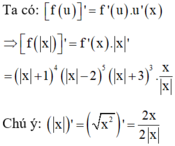Tìm đạo hàm của hàm số y = x 5 + 4 x 5
A. y ' = 1 5 x 4 5 + 10 x 3
B. y ' = 1 2 x 5 + 10 x 4 x 5
C. y ' = 1 5 x 4 5 + 10 x 3
D. y ' = 1 2 x 5 + 2 x 5
Hãy nhập câu hỏi của bạn vào đây, nếu là tài khoản VIP, bạn sẽ được ưu tiên trả lời.

\(a,y'=\left(x^3-4x^2+5\right)'=3x^2-8x\\ b,y''=\left(3x^2-8x\right)'=6x-8\)

1) \(f\left(x\right)=2x-5\)
\(f'\left(x\right)=2\)
\(\Rightarrow f'\left(4\right)=2\)
2) \(y=x^2-3\sqrt[]{x}+\dfrac{1}{x}\)
\(\Rightarrow y'=2x-\dfrac{3}{2\sqrt[]{x}}-\dfrac{1}{x^2}\)
3) \(f\left(x\right)=\dfrac{x+9}{x+3}+4\sqrt[]{x}\)
\(\Rightarrow f'\left(x\right)=\dfrac{1.\left(x+3\right)-1.\left(x+9\right)}{\left(x-3\right)^2}+\dfrac{4}{2\sqrt[]{x}}\)
\(\Rightarrow f'\left(x\right)=\dfrac{x+3-x-9}{\left(x-3\right)^2}+\dfrac{2}{\sqrt[]{x}}\)
\(\Rightarrow f'\left(x\right)=\dfrac{12}{\left(x-3\right)^2}+\dfrac{2}{\sqrt[]{x}}\)
\(\Rightarrow f'\left(x\right)=2\left[\dfrac{6}{\left(x-3\right)^2}+\dfrac{1}{\sqrt[]{x}}\right]\)
\(\Rightarrow f'\left(1\right)=2\left[\dfrac{6}{\left(1-3\right)^2}+\dfrac{1}{\sqrt[]{1}}\right]=2\left(\dfrac{3}{2}+1\right)=2.\dfrac{5}{2}=5\)

\(a,y'=8x^3-10x\\ \Rightarrow y''=24x^2-10\\ b,y'=e^x+xe^x\\ \Rightarrow y''=e^x+e^x+xe^x=2e^x+xe^x\)

a.
\(y'=\dfrac{\left(sinx+cosx\right)'}{2\sqrt{sinx+cosx}}=\dfrac{cosx-sinx}{2\sqrt{sinx+cosx}}\)
b.
\(y'=\dfrac{-4}{\left(x-1\right)^2}\)
Tiếp tuyến vuông góc với \(y=\dfrac{1}{4}x+5\) nên có hệ số góc thỏa mãn \(k.\left(\dfrac{1}{4}\right)=-1\Rightarrow k=-4\)
\(\Rightarrow\dfrac{-4}{\left(x-1\right)^2}=-4\Rightarrow\left(x-1\right)^2=1\)
\(\Rightarrow\left[{}\begin{matrix}x=0\Rightarrow y=-3\\x=2\Rightarrow y=5\end{matrix}\right.\)
Có 2 tiếp tuyến thỏa mãn: \(\left[{}\begin{matrix}y=-4x-3\\y=-4\left(x-2\right)+5\end{matrix}\right.\)

a) \(y' = 2.3{{\rm{x}}^2} - \frac{1}{2}.2{\rm{x}} + 4.1 - 0 = 6{{\rm{x}}^2} - x + 4\).
b) \(y' = \frac{{{{\left( { - 2{\rm{x}} + 3} \right)}^\prime }.\left( {{\rm{x}} - 4} \right) - \left( { - 2{\rm{x}} + 3} \right).{{\left( {{\rm{x}} - 4} \right)}^\prime }}}{{{{\left( {{\rm{x}} - 4} \right)}^2}}}\)
\( = \frac{{ - 2\left( {{\rm{x}} - 4} \right) - \left( { - 2{\rm{x}} + 3} \right).1}}{{{{\left( {{\rm{x}} - 4} \right)}^2}}}\)
\( = \frac{{ - 2{\rm{x}} + 8 + 2{\rm{x}} - 3}}{{{{\left( {{\rm{x}} - 4} \right)}^2}}} = \frac{5}{{{{\left( {{\rm{x}} - 4} \right)}^2}}}\)
c) \(y' = \frac{{{{\left( {{x^2} - 2{\rm{x}} + 3} \right)}^\prime }\left( {{\rm{x}} - 1} \right) - \left( {{x^2} - 2{\rm{x}} + 3} \right){{\left( {{\rm{x}} - 1} \right)}^\prime }}}{{{{\left( {{\rm{x}} - 1} \right)}^2}}}\)
\( = \frac{{\left( {2{\rm{x}} - 2} \right)\left( {{\rm{x}} - 1} \right) - \left( {{x^2} - 2{\rm{x}} + 3} \right).1}}{{{{\left( {{\rm{x}} - 1} \right)}^2}}}\) \( = \frac{{2{{\rm{x}}^2} - 2{\rm{x}} - 2{\rm{x}} + 2 - {x^2} + 2{\rm{x}} - 3}}{{{{\left( {{\rm{x}} - 1} \right)}^2}}}\)
\( = \frac{{{x^2} - 2{\rm{x}} - 1}}{{{{\left( {{\rm{x}} - 1} \right)}^2}}}\)
d) \(y' = {\left( {\sqrt 5 .\sqrt x } \right)^\prime } = \sqrt 5 .\frac{1}{{2\sqrt x }} = \frac{{\sqrt 5 }}{{2\sqrt x }} = \frac{5}{{2\sqrt {5x} }}\).


Do đó hàm số f(|x|) có 3 điểm cực trị tại x= 2; x= -2 và x= 0
Chọn B.

\(a,y'=8x^3-9x^2+10x\\ \Rightarrow y''=24x^2-18x+10\\ b,y'=\dfrac{2}{\left(3-x\right)^2}\\ \Rightarrow y''=\dfrac{4}{\left(3-x\right)^3}\)
\(c,y'=2cos2xcosx-sin2xsinx\\ \Rightarrow y''=-5sin\left(2x\right)cos\left(x\right)-4cos\left(2x\right)sin\left(x\right)\\ d,y'=-2e^{-2x+3}\\ \Rightarrow y''=4e^{-2x+3}\)

Chọn A
f ' ( x ) đổi dấu khi x chạy qua -1 và 3 nên hàm số có 2 điểm cực trị.
Chọn C